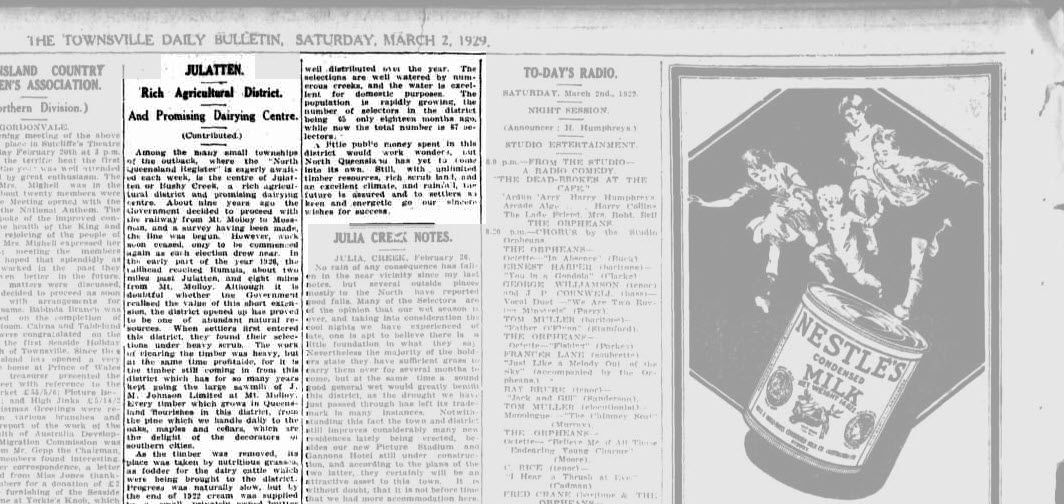Rich Agricultural District. And Promising Dairying Centre.
(Townsville Bulletin, 02/03/1929) Among the many small townships of the outback, where the ‘North Queensland Register’ is eagerly awaited each week, is the centre of Julatten or Bushy Creek, a rich agricultural district and promising dairying centre.
About nine years ago the Government decided to proceed with the railway from Mt. Molloy to Mossman and, a survey having been made, the line was begun. However, work soon ceased, only to be commenced again as each election drew near. In the early part of the year 1926, the railhead reached Rumula, about two miles past Julatten, and eight miles from Mt. Molloy. Although it is doubtful whether the Government realised the value of this short extension, the district opened up has proved to be one of abundant natural resources.
When settlers first entered this district, they found their selections under heavy scrub. The work of clearing the timber was heavy, but at the same time profitable, for it is the timber still coming in from this district which has for so many years kept going the large sawmill of J. M. Johnson Limited at Mt. Molloy. Every timber which grows in Queensland flourishes in this district, from the pine which we handle daily to the oaks, maples and cedars, which are the delight of the decorators of southern cities.
As the timber was removed, its place was taken by nutritious grasses as fodder for the dairy cattle which were being brought to the district. Progress was naturally slow, but by the end of 1922 cream was supplied to a small privately owned butter factory at Molloy. By the middle of 1923 the dairymen had heard the call of co-operation, and it was decided to build a co-operative butter factory at their own centre. Early in 1924 the baby factory was opened. Wisdom was shown by the shareholders in building something within their means. The machinery in the new factory consisted of a twelve box churn, and power was supplied by a h.p. engine.
Operations having commenced, the business began to grow at an astonishing rate. The progress made can be judged by the fact that the amount of butter made in 1928 showed an increase over the two previous years of 62 per cent. As time went on the need for a pasteuriser and refrigeration plant was urgently felt. In 1928 the directors decided that the time had arrived to extend the building which was now far too small, and to install the new machinery.
The finances of the factory were in such healthy condition that a £24OO contract was let to Messrs Wildridge and Sinclair. Mr. G. Marshall being the sub-contractor. Work on the additions was commenced in October last, and is now almost completed. The fixing of the new machinery has at times considerably interfered with the work of the factory, but the manufacture of butter has continued throughout. The new machinery includes a 300 Batch Pasteuriser. Extra power is supplied by a 20 h.p. steam boiler, Colonial type, and a 10 h.p. steam engine, the 6 h.p. Lister now being used as an auxiliary. The Installation includes a six-ton refrigeration compressor. Butter is made three limes week, and it is expected that a new churn will have to be added in the near future. The number of suppliers is at present 22, the maximum to date being 26. The amount of butter made during the month of January was 6822lb. The output is expected to rise to one ton per week in the near future.
The manager of the factory is Mr. J. Wilkinson, a man with considerable experience in butter making. He is assisted by his son. Mr. Wilkinson also acts as local postmaster, as the post office is worked in connection with the factory. Progress has been so steady that the Postmaster General has decided the district warrants a telephone exchange, and Mr. Wilkinson’s duties are soon to be increased by the installation of an exchange at the factory.
But it is not on dairying and timber alone that this promising district depends on, for each year the climate and soil are proved suitable for some new crop. Among the settlers who are proving the value of the soil might be mentioned Mr. McDougall a farmer from the New England district of New South Wales. On the flat just below his residence is a banana plantation, and the site and quality of the bananas grown there speak well for the future of this industry, when a larger northern population creates the demand. At present these fine bananas are often fed to the pigs. Mr. McDougall has also demonstrated the suitability of this district for corn, and a crop of Red Hogan grown on this farm last year would have the Tableland growers green with envy. Other sidelines on this farm are a flock of about one hundred turkeys, and a large herd of pigs.
Mr. Bechtel is another farmer, who has tried poultry, his particular line being fowls, and he has found this venture very profitable. Among other crops, Mr. John Brown has grown fine potatoes, while Mr. Bechtel has also proved that cotton flourishes in this district. A crop which has been very successfully tried is sugar cane and it is the hope of more than one Julatten settler that the suggested tramline extension from Mossman mill to this district may yet eventuate. Yet another venture which has proved successful is bee-farming, and honey sold under the label of F. Norman and Son has a large sale in the district.
That Julatten has the type of settler anxious and ready to take their part in public affairs is proved by the fact that this small township has two representatives on the Woothakata Shire Council In the persons of Messrs Meldren and Geraghty.
One drawback which this district feels is the need of a road to Port Douglas. The present awful road passing round near Molloy and over ‘The Bump’ is one of those roads over which the traveller hopes he will never return. This difficulty is at present being overcome by the public spirit and energy of the settlers. By voluntary labor and public subscriptions a road is under construction. The route followed runs close to the now pigeon-holed railway survey. Several miles have been completed and it is hoped that before the end of April a road with no more difficult grades than one in thirty will connect this district with the coast. Such energy and public spirit are seldom met with even in isolated places.
Another convenience which is sadly needed is a public hall. The difficulty is also being overcome by voluntary labor and at time of writing a start has been made, and the blocks for a fairly substantial building are in position.
In 1924 a Provisional School was opened in the residence of Mr. W. Meldren, but the Education Department shortly after erected a roomy building of the L type, Now some 33 pupils work under the guidance of Acting Head Teacher Mr. Evans, the Head Teacher, Mr. M. J. Pedrazzini being on six months’ leave. Mr. Pedrazzini had demonstrated his confidence in the district by erecting at his at his own expense a large and typical North Queensland residence.
The only business place in the Township is that of Mr. R. Newberry. In July 1928 Mr. Newberry decided to test the business prospects of the district, which had previously been served by Mt. Molloy, and opened a store in a small building centrally situated. Business was so brisk that within three months he persuaded Mr. Meldren, a successful dairy farmer, to erect a much larger building which Mr. Newberry took over in October1928. Already he is doing a large turnover, mostly on a cash (…)
The prospects of this district are bright. The rainfall is sufficient and well distributed over the year. The selections are well watered by numerous creeks, and the water is excellent for domestic purposes. The population is rapidly growing, the number of selectors in the district being 65 only eighteen months ago, while now the total number is 87. A little public money spent in this district would work wonders, but North Queensland has yet to come into its own. Still, with unlimited timber resources, rich scrub land, and an excellent climate, and rainfall, the future is assured and to the settlers who are keen and energetic go our sincere wishes for success.


